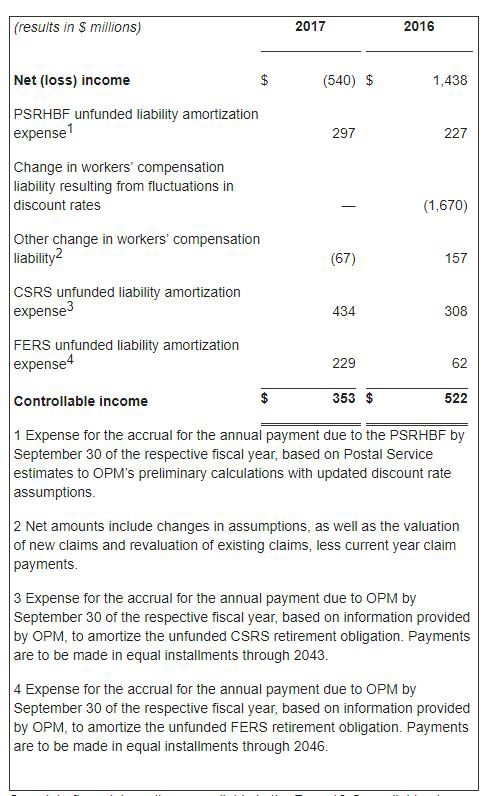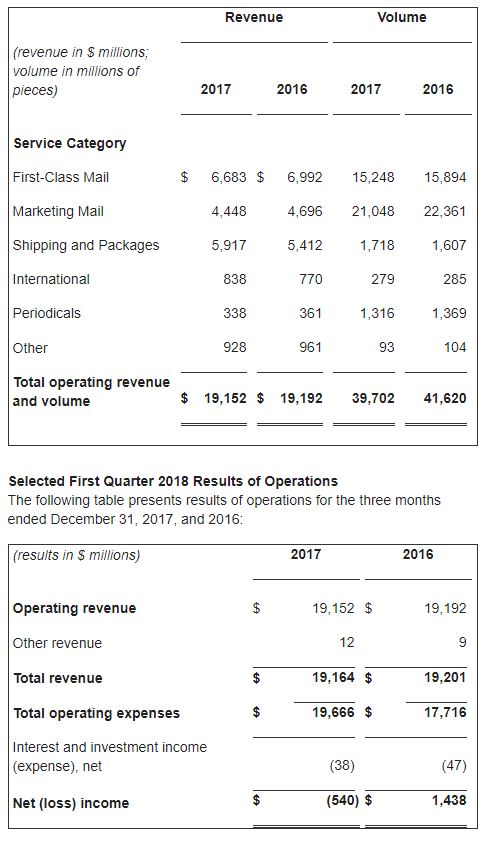Urgent need remains for postal reform legislation and regulatory changes
Mail declines not offset by strong package growth
Accelerated downward trend of primary source of revenue continues
February 12, 2018 - WASHINGTON - The U.S. Postal Service reported controllable income for the first quarter 2018 (October 1, 2017 - December 31, 2017) of $353 million, compared to controllable income of $522 million for the same period last year.  This decrease was largely driven by volume declines in First-Class and Marketing Mail, higher normal cost of retiree health benefits expenses of $140 million and higher transportation expenses of $109 million, partially offset by a reduction in compensation and benefits expenses of $91 million.
This decrease was largely driven by volume declines in First-Class and Marketing Mail, higher normal cost of retiree health benefits expenses of $140 million and higher transportation expenses of $109 million, partially offset by a reduction in compensation and benefits expenses of $91 million.
Total revenue for the quarter was $19.2 billion, essentially unchanged compared to the same quarter last year. Revenue from First-Class Mail and Marketing Mail decreased $309 million and $248 million, respectively, due largely to lower volumes. Revenue from the Shipping and Packages business increased $505 million, or 9.3 percent, during the quarter.
Operating expenses for the quarter were $19.7 billion, an increase of $2.0 billion, or 11.0%, compared to the same period last year. This was largely driven by an increase in workers’ compensation expense of $1.4 billion, resulting from changes in interest rates. Also contributing to this increase were increases in unfunded retirement benefit costs and retiree health benefits expense of $293 million and $210 million, respectively, driven by changes in actuarial assumptions.
Net loss for the first quarter totaled $540 million, compared to net income of $1.4 billion, for the same period last year. The first quarter, which includes the holiday mailing season, is typically the Postal Service's strongest quarter of the fiscal year.
In the first quarter 2018, package volumes grew by 111 million pieces, or approximately 7%, while mail volumes declined by approximately 2.0 billion pieces, or approximately 5%, continuing a multi-year trend of increasing package volume and declining letter volumes. The Postal Service set a record on December 18th when more than 37 million packages were delivered, the most packages delivered in a single day in the organization's more than 240 year history.
"Although we continue to win customers and grow our package business, these gains are not sufficient to offset continuing declines in our mail business, which is our main source of revenue and contribution,” said Postmaster General and CEO Megan J. Brennan. “We will continue to do everything within our control to improve operating efficiencies, manage expenses, expand our use of technology and keep mail affordable, but these actions must be combined with regulatory and legislative changes.”
Brennan added that the Postal Service's abilities to react to declining volumes by controlling costs or growing revenue through pricing flexibility are constrained by current law. These legal constraints are widening a systematic financial imbalance.
The Postal Service's long-term financial stability also depends on the Postal Regulatory Commission (PRC) establishing a new pricing system that enables the organization to generate sufficient revenues to cover our costs. The Postal Service agrees with the conclusion of the PRC that the current Consumer Price Index price cap does not work and needs to be changed, because it does not enable the Postal Service to achieve its mission of providing prompt, reliable, and efficient universal postal services to the American people in a financially sustainable manner.
“Continuing mail declines that totaled 2 billion pieces in this quarter place additional financial pressure on us, underscoring the need for change,” said Chief Financial Officer Joseph Corbett.
First Quarter 2018 Operating Revenue and Volume by Service Category Compared to Prior Year
The following presents revenue and volume by category for the three months ended December 31, 2017, and 2016:
Controllable Income
This news release references controllable income, which is not calculated and presented in accordance with accounting principles generally accepted in the United States (GAAP). Controllable income is a non-GAAP financial measure defined as net (loss) income adjusted for items outside of management’s control and non-recurring items. These adjustments include workers’ compensation expenses caused by actuarial revaluation and discount rate changes, and the amortization of PSRHBF, CSRS and FERS unfunded liabilities.
The following table reconciles the Postal Service's GAAP net (loss) income to controllable income and illustrates the income from ongoing business activities without the impact of non-controllable items for the three months ended December 31, 2017, and 2016:
Complete financial results are available in the Form 10-Q, available at http://about.usps.com/who-we-are/financials/welcome.htm.
The Postal Service receives no tax dollars for operating expenses and relies on the sale of postage, products and services to fund its operations.
Source: USPS

